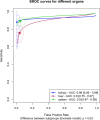Diagnostic performance of contrast-enhanced ultrasound in traumatic solid organ injuries in children: a systematic review and meta-analysis
- PMID: 39671007
- PMCID: PMC11805793
- DOI: 10.1007/s00247-024-06127-9
Diagnostic performance of contrast-enhanced ultrasound in traumatic solid organ injuries in children: a systematic review and meta-analysis
Abstract
Background: Blunt abdominal trauma (BAT) is a significant contributor to pediatric mortality, often causing liver and spleen injuries. Contrast-enhanced computed tomography (CT), the gold standard for diagnosing solid organ injury, poses radiation risks to children. Contrast-enhanced ultrasound (CEUS) may be a promising alternative imaging modality.
Objectives: To evaluate the diagnostic utility of CEUS for detecting solid organ injuries following BAT in the pediatric population.
Methods: A systematic review and meta-analysis were conducted through a thorough literature search in PubMed, Scopus, Web of Science, and Embase databases up to October 1, 2023. Diagnostic accuracy metrics were aggregated using a bivariate model, and subgroup meta-analysis compared CEUS accuracy across various organs.
Results: Meta-analysis from four studies, including 364 pediatric patients, revealed a pooled sensitivity of 88.5% (95%CI 82.5-92.6%) and specificity of 98.5% (95%CI 94.9-99.6%), with an area under the curve of 96% (95%CI 88 - 99%). Splenic injuries showed higher sensitivity than liver injuries (P-value < 0.01), while kidney assessments demonstrated higher specificity (P-value < 0.05).
Conclusion: This study highlights the diagnostic potential of CEUS for pediatric solid organ injuries caused by BAT. Further large-scale studies are needed due to the limited number and sample size of the included studies.
Keywords: Abdominal injuries; Blunt abdominal trauma; Contrast-enhanced ultrasound; Diagnostic imaging; Pediatric trauma; Solid organ injuries.
© 2024. The Author(s).
Conflict of interest statement
Declarations. Ethical approval: This study, being a review and not involving patient data, did not require institutional ethical approval. Informed consent: As this study was a review and did not involve patient data, obtaining informed consent was not applicable. Generative AI and AI-assisted technologies in the writing process: We acknowledge ChatGPT, an OpenAI language model based on the GPT-4 architecture, for assisting with language corrections during the article’s editing. The model enhanced the readability and language quality of the publication. However, the authors retain full responsibility for the content, having reviewed and edited it as needed after using the tool. Conflicts of interest: None
Figures









References
-
- Villavicencio F, Perin J, Eilerts-Spinelli H et al (2024) Global, regional, and national causes of death in children and adolescents younger than 20 years: an open data portal with estimates for 2000–21. Lancet Glob Heal 12:e16–e17 - PubMed
-
- Lynn KN, Werder GM, Callaghan RM et al (2009) Pediatric blunt splenic trauma: a comprehensive review. Pediatr Radiol 39:904–930 - PubMed
-
- Kim YY, Jeong YJ, Jung SH, Kim JC (2010) Clinical analysis of blunt abdominal trauma in childhood. J Korean Assoc Pediatr Surg 16:177
-
- Gaines BA (2009) Intra-abdominal solid organ injury in children: diagnosis and treatment. J Trauma Inj Infect Crit Care 67:S135–S139 - PubMed
-
- Miele V, Piccolo CL, Trinci M et al (2016) Diagnostic imaging of blunt abdominal trauma in pediatric patients. Radiol Med 121:409–430 - PubMed
Publication types
MeSH terms
Substances
LinkOut - more resources
Full Text Sources

